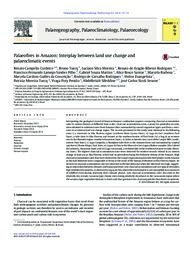Palaeofires in Amazon: Interplay between land use change and palaeoclimatic events.
Palaeofires in Amazon: Interplay between land use change and palaeoclimatic events.
Author(s): CORDEIRO, R. C.; TURCQ, B.; MOREIRA, L. S.; RODRIGUES, R. de A. R.; SIMÕES FILHO, F. F. L.; MARTINS, G. S.; SANTOS, A. B.; BARBOSA, M.; CONCEIÇÃO, M. C. G. da; RODRIGUES, R. de C.; EVANGELISTA, H.; MOREIRA-TURCQ, P.; PENIDO, Y. P.; SIFEDDINE, A.; SEOANE, J. C. S.
Summary: Interpreting the geological record of Amazon biomass combustion requires comparing charcoal accumulation rates in various biomes at different time scales. Charcoal accumulation rates, a proxy for palaeofire records, were obtained in sediment cores from Amazon lakes surrounded by several vegetation types and from a reservoirs in an intense land use change region. The records presented in this study were obtained in the following areas i) a reservoirs in Alta Floresta region (northern Mato Grosso State); ii) Lago do Saci (southern Pará State), a lake close to Alta Floresta and located at the southern border of Pará State; iii) a bog in an ecotone area in the Humaitá region (southern Amazonas State); iv) lakes in lateritic iron crust of the Carajás Hills (southeastern Pará State); v) Lago Comprido, a floodplain lake close to the Amazon River and surrounded by tropical rain forest (Monte Alegre, Pará State; vi) Lagoa da Pata in the Morro dos Seis Lagos alkaline complex (São Gabriel da Cachoeira, Amazonas State) and vii) Lago Caracaranã, a secluded lake in the northern Amazon cerrado (Roraima State). The highest charcoal accumulation rates were observed for modern records related to an intense change in land use at Alta Floresta, which had no precedent during the Holocene history of the Amazon. High charcoal accumulation rates that were observed in the Carajás region during low lake level phases in the Amazon in the mid-Holocene were comparable to those at the onset of the human settlement in Alta Floresta region. An increase in charcoal accumulation rate was observed in the late Holocene when the lake level was high, suggesting an interaction between climates and human presence. Low charcoal accumulation rates are typical of modern high rainfall environments, as observed in Lagoa da Pata where the environment is not susceptible to occurrences of wildfires even during relatively drier climatic phases. Low charcoal accumulation rates also exist in the relatively dry cerrado (savanna type) biome even during relatively dry phases in the Caracaranã region where the savanna-type vegetation biomass is lower and thus generates less charcoal particles than forest ecosystems.
Publication year: 2014
Types of publication: Journal article
Keywords: Amazonia, Carvão Vegetal, Charcoal, Climate change
Observation
Some of Embrapa's publications are published as ePub files. To read them, use or download one of the following free software options to your computer or mobile device. Android: Google Play Books; IOS: iBooks; Windows and Linux: Calibre.
Access other publications
Access the Agricultural Research Database (BDPA) to consult Embrapa's full library collection and records.
Visit Embrapa Bookstore to purchase books and other publications sold by Embrapa.

